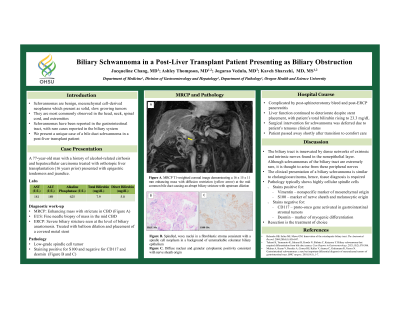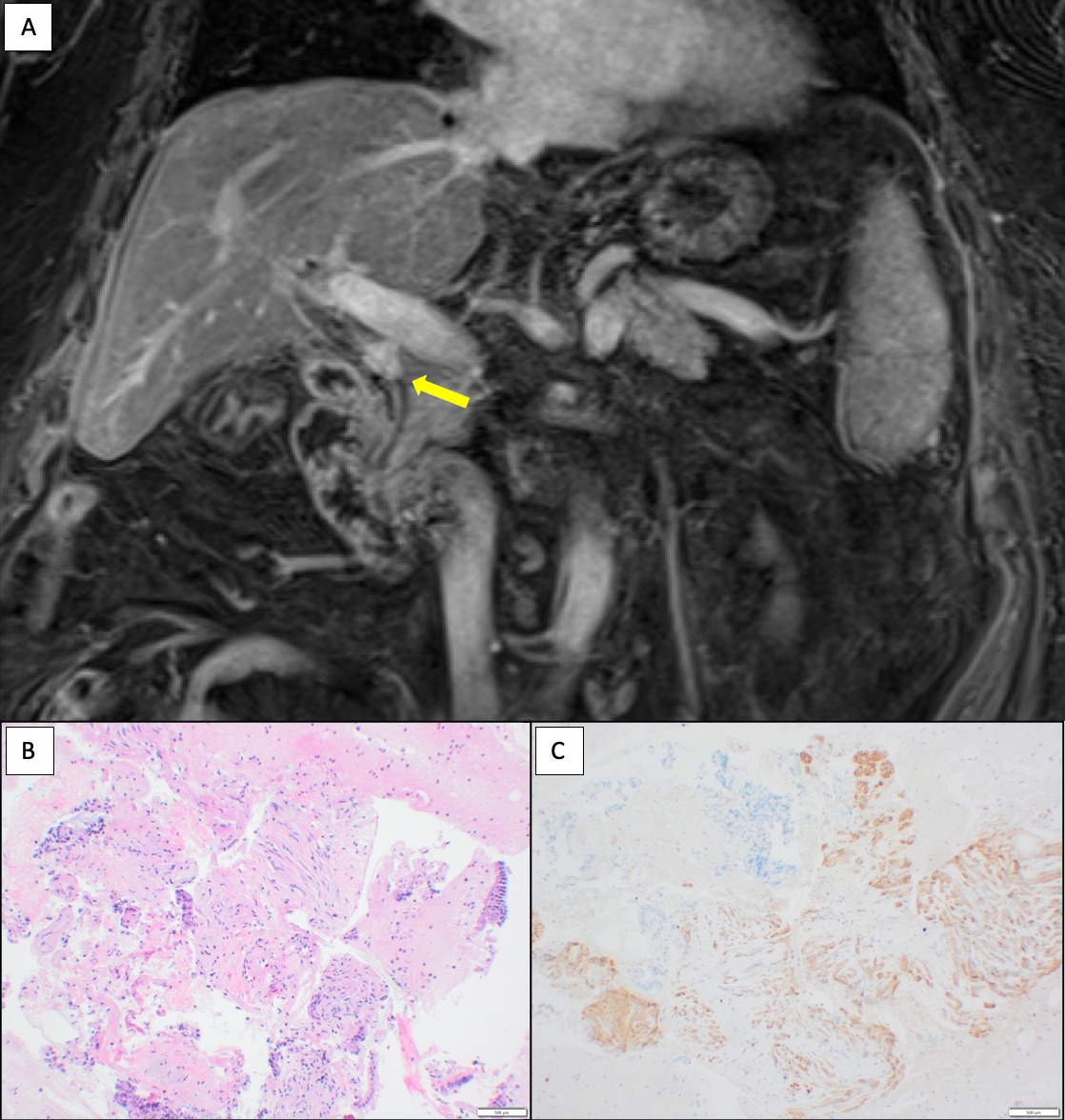Back


Poster Session D - Tuesday Morning
Category: Biliary/Pancreas
D0067 - Biliary Schwannoma in a Post-Liver Transplant Patient Presenting as Biliary Obstruction
Tuesday, October 25, 2022
10:00 AM – 12:00 PM ET
Location: Crown Ballroom

Has Audio
- JC
Jacqueline P. Chang, MD
Oregon Health & Science University
Portland, OR
Presenting Author(s)
Jacqueline P. Chang, MD, Ashley Thompson, MD, Jogarao Vedula, MD, Kaveh Sharzehi, MD
Oregon Health & Science University, Portland, OR
Introduction: Schwannomas are benign, mesenchymal-derived neoplasms which present as solid, slow growing tumors. They can rarely be observed in the gastrointestinal (GI) tract, with very limited reports of them occurring in the biliary system. In this case, we describe a bile duct schwannoma in a post-liver transplant patient.
Case Description/Methods: A 77-year-old man with a history of alcohol-related cirrhosis with hepatocellular carcinoma treated with orthotopic liver transplantation 16 years prior, and end stage renal disease on hemodialysis presented with jaundice. Labs demonstrated new elevations in his liver enzymes: AST 181 U/L, ALT 189 U/L, alkaline phosphatase 625 U/L, total bilirubin (TB) 7.9 mg/dL, and direct bilirubin 5.0 mg/dL.
A magnetic resonance cholangiopancreatography was performed and demonstrated a 16 x 15 x 11 mm enhancing mass causing abrupt narrowing of the mid common bile duct (CBD) with upstream duct dilation to 10 mm (Figure 1A) without other discrete mass identified. A follow-up endoscopic ultrasound confirmed a hypoechoic mass in the mid CBD and fine needle biopsy was obtained. An endoscopic retrograde cholangiopancreatography was subsequently performed, which demonstrated a severe biliary stricture at the level of the prior biliary anastomosis which was treated with balloon dilation and placement of a covered metal stent. The procedure was complicated by post-sphincterotomy bleed and mild post-ERCP pancreatitis. His liver enzymes failed to improve, and his TB progressively worsened to 23.3 mg/dL. Pathology returned showing a low-grade spindle cell tumor (Figure 1B), with staining positive for S100 (Figure 1C) and negative for CD117 and desmin, consistent with a diagnosis of schwannoma. Surgical intervention was not pursued, in line with his goals of care, and he was ultimately transitioned to comfort-oriented care and passed five days after admission.
Discussion: Schwannomas are rare neoplasms which can arise from the nonepithelial wall of the GI tract containing nerve fibers. They are composed of highly cellular spindle cells which stain positive for vimentin (marker of mesenchymal origin) and S100 protein (marker of nerve sheath origin), and negative for CD117 (marker of GI stromal tumors) and desmin (muscle cell marker). Neoplasms can often be suspected in late presentations of post-transplant biliary obstruction. To our knowledge, this is the first case report of a biliary schwannoma occurring at the site of a biliary anastomosis in a liver transplant patient.

Disclosures:
Jacqueline P. Chang, MD, Ashley Thompson, MD, Jogarao Vedula, MD, Kaveh Sharzehi, MD. D0067 - Biliary Schwannoma in a Post-Liver Transplant Patient Presenting as Biliary Obstruction, ACG 2022 Annual Scientific Meeting Abstracts. Charlotte, NC: American College of Gastroenterology.
Oregon Health & Science University, Portland, OR
Introduction: Schwannomas are benign, mesenchymal-derived neoplasms which present as solid, slow growing tumors. They can rarely be observed in the gastrointestinal (GI) tract, with very limited reports of them occurring in the biliary system. In this case, we describe a bile duct schwannoma in a post-liver transplant patient.
Case Description/Methods: A 77-year-old man with a history of alcohol-related cirrhosis with hepatocellular carcinoma treated with orthotopic liver transplantation 16 years prior, and end stage renal disease on hemodialysis presented with jaundice. Labs demonstrated new elevations in his liver enzymes: AST 181 U/L, ALT 189 U/L, alkaline phosphatase 625 U/L, total bilirubin (TB) 7.9 mg/dL, and direct bilirubin 5.0 mg/dL.
A magnetic resonance cholangiopancreatography was performed and demonstrated a 16 x 15 x 11 mm enhancing mass causing abrupt narrowing of the mid common bile duct (CBD) with upstream duct dilation to 10 mm (Figure 1A) without other discrete mass identified. A follow-up endoscopic ultrasound confirmed a hypoechoic mass in the mid CBD and fine needle biopsy was obtained. An endoscopic retrograde cholangiopancreatography was subsequently performed, which demonstrated a severe biliary stricture at the level of the prior biliary anastomosis which was treated with balloon dilation and placement of a covered metal stent. The procedure was complicated by post-sphincterotomy bleed and mild post-ERCP pancreatitis. His liver enzymes failed to improve, and his TB progressively worsened to 23.3 mg/dL. Pathology returned showing a low-grade spindle cell tumor (Figure 1B), with staining positive for S100 (Figure 1C) and negative for CD117 and desmin, consistent with a diagnosis of schwannoma. Surgical intervention was not pursued, in line with his goals of care, and he was ultimately transitioned to comfort-oriented care and passed five days after admission.
Discussion: Schwannomas are rare neoplasms which can arise from the nonepithelial wall of the GI tract containing nerve fibers. They are composed of highly cellular spindle cells which stain positive for vimentin (marker of mesenchymal origin) and S100 protein (marker of nerve sheath origin), and negative for CD117 (marker of GI stromal tumors) and desmin (muscle cell marker). Neoplasms can often be suspected in late presentations of post-transplant biliary obstruction. To our knowledge, this is the first case report of a biliary schwannoma occurring at the site of a biliary anastomosis in a liver transplant patient.

Figure: Figure 1: A) MRCP T1-weighted coronal image demonstrating a 16 x 15 x 11 mm enhancing mass with diffusion restriction (yellow arrow) at the mid common bile duct causing an abrupt biliary stricture with upstream dilation, B) 10x magnification H&E showing spindled, wavy nuclei in a fibroblastic stroma consistent with a spindle cell neoplasm in a background of unremarkable columnar biliary epithelium,
C) 10x magnification S100 immunohistochemical stain showing diffuse nuclear and granular cytoplasmic positivity consistent with nerve sheath origin.
C) 10x magnification S100 immunohistochemical stain showing diffuse nuclear and granular cytoplasmic positivity consistent with nerve sheath origin.
Disclosures:
Jacqueline Chang indicated no relevant financial relationships.
Ashley Thompson indicated no relevant financial relationships.
Jogarao Vedula indicated no relevant financial relationships.
Kaveh Sharzehi indicated no relevant financial relationships.
Jacqueline P. Chang, MD, Ashley Thompson, MD, Jogarao Vedula, MD, Kaveh Sharzehi, MD. D0067 - Biliary Schwannoma in a Post-Liver Transplant Patient Presenting as Biliary Obstruction, ACG 2022 Annual Scientific Meeting Abstracts. Charlotte, NC: American College of Gastroenterology.
